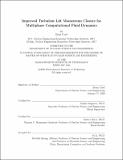Improved turbulent lift momentum closure for multiphase computational fluid dynamics
Author(s)
Casel, Brian(Brian Scott)
Download1237645551-MIT.pdf (5.227Mb)
Other Contributors
Massachusetts Institute of Technology. Department of Nuclear Science and Engineering.
Advisor
Emilio Baglietto.
Terms of use
Metadata
Show full item recordAbstract
More efficient boiling heat transfer systems in nuclear reactors can help lower the costs of a large, low carbon energy source. Multiphase computational fluid dynamics (M-CFD) can be utilized in the design of these systems, but requires additional modeling for interphase transfer of mass, momentum, and energy [1]. Within the momentum transfer between phases, the interfacial lift force strongly affects the lateral migration of the gas phase in bubbly flow, which strongly impacts the predictions of pressure drop and heat transfer [2]. Recent work from Sugrue has proposed an improved physical representation of the turbulent lift force utilizing a combination of direct numerical simulation (DNS) data and a numerical optimization of the lift coefficient using experimental data [3]. The resulting Sugrue lift model yielded consistent and improved predictions of lateral redistribution of the gas phase in adiabatic air-water experiments; however, application to developing, bubbly flow has shown there is potential to further improve the accuracy of the formulation [4, 5]. In this work, a systematic optimization to the turbulent lift model is performed to adjust the Sugrue model and a new turbulent lift model is proposed. Both formulations out-perform the original Sugrue model on the Hibiki [6] experiment and the new turbulent lift model marginally improves performance on the TOPFLOW [7] experiments. Additionally, machine learning methods including k-nearest neighbors, principal component analysis, linear regression, random forests, and neural networks, are used to analyze M-CFD data to highlight parameters for future modeling. The linear regression and random forest methods both suggest that superficial liquid and gas velocities (J[subscript l] and J[subscript g]), and slip ratio (S) are the three most important variables for modeling the lift coefficient. Additional data is needed to extract more precise modeling information from the candidate machine learning models in future study.
Description
Thesis: S.M., Massachusetts Institute of Technology, Department of Nuclear Science and Engineering, February, 2020 Cataloged from student-submitted PDF of thesis. Includes bibliographical references (pages 63-65).
Date issued
2020Department
Massachusetts Institute of Technology. Department of Nuclear Science and EngineeringPublisher
Massachusetts Institute of Technology
Keywords
Nuclear Science and Engineering.